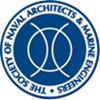船舶随波保持航向的动力失稳易损性判据
IF 1
4区 工程技术
Q3 ENGINEERING, CIVIL
引用次数: 0
摘要
提出并评价了一种实用的准则,可用于评估船舶在波浪中的航向保持能力。目前,它考虑了规则波,并通过应用谐波平衡方法对航向不稳定区边界进行分析估计而产生。计算是针对三阶偏航方程进行的,该方程源自船舶操纵运动的经典摇摆-偏航-方向舵模型,具有两个位置的时间相关系数,类似于扩展到三阶的Mathieu型方程。针对该摇摆-偏航模型的模拟,对所提出的分析标准进行了全面评估,发现其足够准确。还考虑了一个补充的准静态偏航稳定性标准(适用于遇到频率接近零的船舶操作,相对于波浪),以确定哪一个标准在各种操作条件下产生更严格的要求。在第二代完整稳定性标准的背景下,所提出的标准可能是一种额外的脆弱性检查。自70多年前(Davidson 1948)以来,船舶在后续海域操纵的困难一直受到研究界的关注。一个相关的研究方向是避免出现不稳定性,特别是制定实用标准,以确保船舶在遇到陡峭的后浪时有足够的航向保持能力。关于这一主题的一些经典著作,如DuCane和Goodrich(1962)、Wahab和Swaan(1964)以及Motora等人(1981)的著作,都集中于船舶在波浪上的准静态条件,如果船舶以等于波浪速度(零遭遇频率)的速度前进,则可以实际实现这一条件。正如所暗示的那样,这些工作主要集中在避免一种在实现冲浪之前出现的不稳定现象,这种现象是船只被迫随波浪移动,通常是下坡行驶。本文章由计算机程序翻译,如有差异,请以英文原文为准。
A Vulnerability Criterion of Dynamic Instability for Ship Course-Keeping in Following Waves
A practical criterion which can be used for assessing the course-keeping capability of a ship in following waves, is proposed and evaluated. Presently, it accounts for regular waves and it accrued from an analytical estimation of the course instability region’s boundary by applying the method of harmonic balance. The calculation is performed with regard to the third-order yaw equation, derived from a classic sway-yaw-rudder model of ship maneuvering motions, with time-dependent coefficients at two places, which is like a Mathieu-type equation extended to third order. The proposed analytical criterion was evaluated thoroughly against simulations with regard to this sway-yaw model and it was found to be adequately accurate. A supplementary quasi-static yaw stability criterion (fitting to ship operation with frequency of encounter, with respect to the waves, close to zero) was also considered in order to determine which one yields more stringent requirements, for various operating conditions. The proposed criterion could be an extra vulnerability check for broaching-to, in the context of the Second Generation Intact Stability Criteria.
The difficulties of steering of ships in following seas have received the attention of the research community since more than 70 years ago (Davidson 1948). A relevant direction of research refers to the avoidance of the broaching-to instability and, in particular, to the development of practical criteria that could ensure sufficient course-keeping capability for a ship encountering steep following waves. Some classic works on this topic, such as those of DuCane and Goodrich (1962), Wahab and Swaan (1964), and Motora et al. (1981), were focused on the quasi-static condition of a ship on the wave which could be practically realized if the ship was advancing with speed equal to the wave celerity (zero frequency of encounter). As implied, these works were essentially focused on the avoidance of a type of broaching-to instability that is preceded by the realization of surf-riding, a phenomenon where the ship is forced to move with the wave, usually riding a downslope.
求助全文
通过发布文献求助,成功后即可免费获取论文全文。
去求助
来源期刊

Journal of Ship Research
工程技术-工程:海洋
CiteScore
2.80
自引率
0.00%
发文量
12
审稿时长
6 months
期刊介绍:
Original and Timely technical papers addressing problems of shipyard techniques and production of merchant and naval ships appear in this quarterly publication. Since its inception, the Journal of Ship Production and Design (formerly the Journal of Ship Production) has been a forum for peer-reviewed, professionally edited papers from academic and industry sources. As such, it has influenced the worldwide development of ship production engineering as a fully qualified professional discipline. The expanded scope seeks papers in additional areas, specifically ship design, including design for production, plus other marine technology topics, such as ship operations, shipping economic, and safety. Each issue contains a well-rounded selection of technical papers relevant to marine professionals.
 求助内容:
求助内容: 应助结果提醒方式:
应助结果提醒方式:


